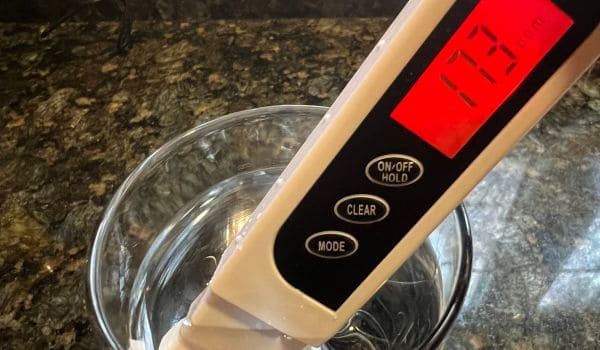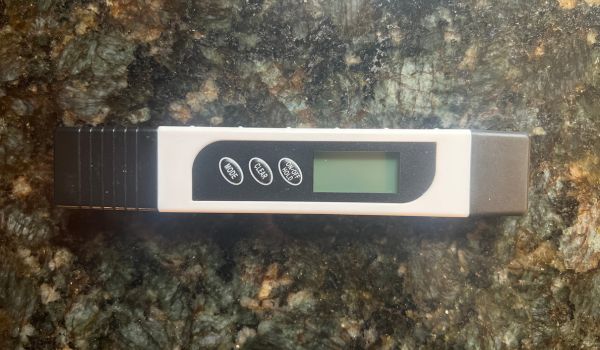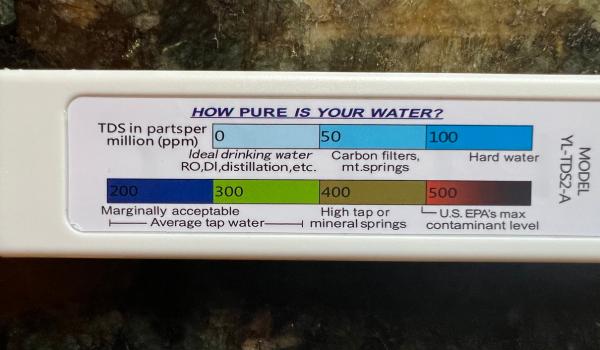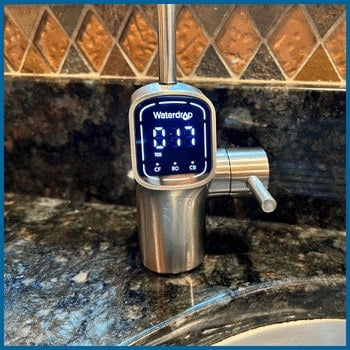If your reverse osmosis (RO) system isn’t delivering the crisp, clean water it used to, a hidden issue called TDS creep could be the cause.
It sounds technical — but it’s easy to understand:
Small amounts of minerals and dissolved solids can slip through the membrane, especially if your system sits unused for long periods.
The good news?
This type of buildup is simple to spot — and even easier to fix once you know what signs to watch for. 🚿
🧠 Quick Takeaways:
- ✅ TDS levels can rise temporarily in idle RO systems.
- ✅ Flushing the system for 30–60 seconds usually clears it out.
- ✅ Regular membrane and filter maintenance keeps dissolved solids in check.
- ✅ Newer RO models with built-in monitors make detecting problems effortless.
🧪 What Is TDS (Total Dissolved Solids)?

TDS — or Total Dissolved Solids — sounds like technical jargon, but it simply refers to the tiny minerals, salts, and metals dissolved in your water.
They’re invisible, but they impact everything from taste to system performance. Here’s what you need to know:
- 🧂 Minerals and Metals: TDS includes harmless minerals like calcium and magnesium — and sometimes unwanted traces of heavy metals.
- 🥤 Taste Impact: High TDS often gives water a “mineral” or “flat” taste. Low TDS usually tastes cleaner.
- 🏥 Health Connection: Most dissolved solids aren’t dangerous, but extreme levels (too high or too low) can hint at broader water quality issues.
- 🚰 RO Systems Role: Reverse osmosis filters are designed to reduce dissolved solids — keeping water purer and better-tasting.
💬 Helpful Tip:
A simple handheld TDS meter costs under $20 and can quickly show how effectively your RO system is working — no technical skills needed!
🔍 What Causes TDS Buildup in RO Systems?

Even a well-maintained reverse osmosis filter can experience a slow rise in dissolved solids over time. It usually happens when water sits in the system too long without being used — or when parts start to wear out.
Here’s a quick look at the most common culprits: 👇
| ⚙️ Cause | 🔍 What Happens | 💡 Good To Know |
|---|---|---|
| 🚿 Infrequent Use | Water sitting idle allows minerals to slowly seep across the membrane. | Flush the system before each use for freshest results. |
| 🛠️ Aging RO Membrane | Older membranes lose effectiveness and allow more solids through. | Most membranes last 2–5 years depending on water quality. |
| 💧 Changing Source Water | Higher incoming TDS makes it harder for your RO to keep up. | Regular water testing helps catch source water shifts early. |
| 🔧 Poor Installation or Design | Incorrect flow restrictors or system layouts can increase mineral seepage. | Professional installation can reduce long-term performance issues. |
💬 Helpful Tip: If your water usage is low (like a vacation home or secondary sink), you’re more likely to notice a rise in TDS — even if your system is brand new.
🔎 How to Spot Rising TDS in Your RO System

Catching TDS issues early is the easiest way to keep your water quality high and your system running smoothly.
Thankfully, you don’t need special tools (or a plumbing degree) to notice when something’s off. 👀
Here’s what to watch for:
- 🧪 Use a TDS Meter: A quick check before and after filtration can reveal if solids are slipping through.
- 👅 Trust Your Taste Buds: If your water starts tasting slightly salty, metallic, or flat, it’s time to investigate.
- 🚰 Check Fill Times: If your tank refills slower than normal, it could signal a membrane that’s underperforming.
- 👂 Listen for Strange Noises: Gurgling, prolonged cycling, or hissing sounds can hint at pressure or membrane issues.
- 📉 Monitor System Age: If your RO unit is more than 3–5 years old, membrane efficiency naturally declines over time.
💬 Smart Tip: If you’re consistently seeing higher readings on your TDS meter — even after flushing — it’s probably time to check your filters and membrane for wear.
The Meter we used cost less than 15 bucks and works just as good as the expensive ones – so don’t waste your money. See it here.

👉 Learn more about how reverse osmosis systems work and why regular maintenance matters.
🛠️ How to Fix Rising TDS Levels in Your RO System

Catching a slight jump in dissolved solids early usually means you can fix the problem with a few easy steps — no major repairs needed.
Here’s how to stay ahead of the curve and keep your water tasting its best: 👇
- 🔄 Flush the System Regularly: If water sits in the RO tank too long, dissolved solids can sneak through. Run the tap for 30–60 seconds before filling your glass.
- 🧽 Change Filters on Schedule: Old or clogged filters are a common cause of performance drops. Stick to your system’s recommended swap schedule.
- 🛡️ Test Your Membrane: If TDS readings stay high after a flush, your membrane might be nearing the end of its life.
- 🧪 Keep a TDS Meter Handy: Regular spot checks help you spot creeping TDS issues before they become bigger headaches.
- 🛠️ Inspect for Flow Restrictor Problems: If your RO system has a flow restrictor, make sure it’s working properly to maintain pressure balance.
- 👨🔧 Call for a Professional Checkup: A quick inspection from a water specialist every few years can catch hidden issues and save you money long term.
💬 Helpful Tip: Using your RO system daily — even just a few cups of water — is one of the easiest ways to prevent solids from building up while the system sits idle.
🚰 When It’s Time to Upgrade Your RO System

If you’ve flushed, cleaned, and swapped filters — but your TDS levels are still creeping higher — it might be a sign your system is simply aging out.
Modern reverse osmosis systems are smarter, faster, and often much easier to maintain than older models.
Here’s why upgrading can make a real difference:
- 🧠 Simpler Maintenance: Systems like the WaterDrop G3P800 offer easy filter swaps and real-time status updates, making upkeep almost effortless.
- 📊 Built-In TDS Monitors: Many newer systems constantly track water quality, so you know instantly if something’s off — no guessing or manual checks needed.
- 🛡️ Better Membrane Efficiency: Newer RO membranes filter more effectively for longer, reducing maintenance needs and long-term costs.
- ⚙️ Faster Water Flow: Upgraded designs refill tanks quicker and waste less water — a win for both convenience and your water bill.
💬 Smart Move: If you’re battling frequent TDS issues — or your RO system is more than 5 years old — upgrading to a modern, high-efficiency setup could save you time, hassle, and money long-term.
👉 Curious about smart upgrade options?
See our hands-on WaterDrop G3P800 review — it’s the system we use and trust at home.
💭 Final Thoughts: Keeping Your Water Quality on Track
TDS creep might sound like a big problem, but for most homeowners, it’s a small issue that’s easy to manage with a few smart habits.
- ✅ Flushing your system regularly
- ✅ Staying on top of filter and membrane changes
- ✅ Monitoring your water with a simple TDS meter
These small steps make a big difference in keeping your reverse osmosis system running smoothly — and your water tasting the way it should.
And if you ever find yourself fighting rising TDS levels too often, upgrading to a modern RO system with real-time monitoring can take the guesswork out of it for good. 💧
Cleaner water, longer-lasting systems, fewer headaches.
That’s the real win. 🚰
 103 people found this helpful. Was this guide helpful to you?
103 people found this helpful. Was this guide helpful to you? 

